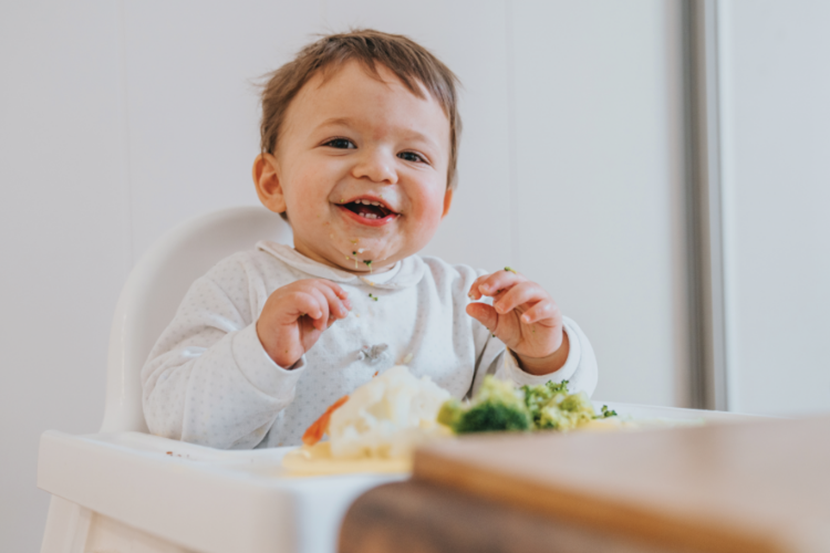Rock solid advice on toddler nutrition

Jenny Douglas from Jumpstart Nutrition talks all things nutrition in the toddler years.
Toddlers have slightly different nutrient needs than a baby. You will often find that your ferocious, will-eat-anything baby is a less enthusiastic eater as a toddler. There is good reason for this! Your baby almost tripled their size from birth – 12 months, and in the toddler years they only gain around 2-3kg and around 3-5cm. As growth slows, so does the appetite. You can expect to have an increase in hunger through growth spurts, but overall, your toddler will seem to eat less than when they were a baby. Now is an important time to remind yourself that your toddler knows how much they need to eat to thrive and you don't need to bribe them into eating their food. Toddlers should continue to be offered the opportunity to eat, but without pressure to finish the plate. As a parent you need to continue offering family foods and avoid rushing off to the kitchen to make an alternative food option if they don’t eat, because most likely they are just not hungry. It is through the toddler years that we sometimes see a ‘fussy eating’ stage, which is a normal developmental stage that is usually outgrown. This developmental stage relates to a fear of ‘new’ things and is a smart protective mechanism to reduce the risk of your independent toddler eating everything in the garden. But it does pose some challenges for mealtimes as your toddler is less likely to try new foods on their plate.

PROTEIN
Protein is a building block for growth and development, and is needed to ensure your toddler get nutrients such as iron and calcium. Protein comes from meat, fish, chicken, eggs, lentils, beans, yoghurt, cheese, and milk. Protein is very useful at each meal and snack as it helps with satiety (feeling full).
CARBOHYDRATES
Carbohydrates are a main fuel for toddlers and come from starchy vegetables, breads, cereals, rice, and other grains. This is one fuel source that toddlers are keen to have and it is not uncommon for a toddler to lean towards a ‘beige’, carbohydrate-heavy diet. This is because these foods often have a texture that is predictable, they are not brightly coloured, and they are often easy to eat. Carbohydrates should be offered at most meals and snacks to keep your little one fuelled for the day, but make sure you offer protein and vegetables alongside them to encourage variety.
FAT
Fat is a very important energy source for toddlers as they often have smaller appetites but need to be fuelled for growth spurts and their day-to-day activities. Fat provides a source of fat-soluble vitamins, such as vitamin E, vitamin A, and omega 3. Ideally focus on healthy fats such as olive oil, avocado, nut butters, or fatty fish over visible meat fat or other animal fats (eg lard). Your toddler is likely to continue to need full-fat milk products to help meet their energy requirements, but you can change your toddler to lower fat milk versions after two years of age if you prefer.
VEGETABLES
Vegetables are a group of foods that are often the least accepted in this age group. Vegetables are brightly coloured, often have variable texture and if not cooked well they can taste a bit bland compared to other foods. So, it’s a common problem for parents to struggle to get any vegetables into children in the toddler years. The key to moving forward is exposure, exposure, exposure! Just because your toddler has rejected a vegetable today, does not mean that you should not offer it again, but instead you need to keep trying alongside some familiar foods to help build acceptance. Vegetables are packed with nutrients such as vitamin A (for eyes/skin health), fibre (for gut health), calcium (for bone health), iron (for brain function), folate (for red blood cells), and much more. Kid’s don’t know this, so tell them! Explain what these nutrients do in the body to help them understand why their parents keep pestering them to eat them. Just saying they are ‘healthy’ has limited meaning, but if you say "Vegetables have vitamin A to help the graze on your knee heal", then it makes more sense to them why they are on their plate.

CALCIUM
Calcium is an important nutrient for bone health. Calcium comes from milk, cheese and yoghurt. Toddlers need around 300-400mls milk (eg breast milk or cow’s milk) per day, but ideally keep this under 500mls as increased milk feeds displace the appetite for foods. Now is a good time to focus on yoghurt and cheese as calcium sources over the day. If your toddler is unable to tolerate cow’s milk, then they should be on a soy or oat milk dairy alternative with at least 120mg calcium per 100mls.
Sources of calcium you might give your toddler:
+ 200mls full fat cow’s milk: 43mg calcium
+ 200mls calcium-fortified alternative milk: 100-240mg calcium
+ 125g yoghurt: 63mg calcium
+ 2 slices cheese: 244mg calcium
+ 25g spinach: 11mg calcium
+ 1tsp tahini: 129mg calcium
IRON
Iron is an essential nutrient for growth and development and for growing healthy minds. Iron requirements during toddlerhood are around 9mg per day, which equates to around 300g red meat (a lot!). Some toddlers struggle with the texture of meat (eg beef, chicken, lamb) and often their iron intake drops off if they are not offered meat that is texture appropriate. Meats that have been slow-cooked, poached or that are minced are usually the most successful in this age group. Trial non-meat options of protein with your toddler too, such as beans/lentils or foods such as hummus that may be at a texture that is more acceptable for them. Iron-fortified cereals, such as Weet-Bix and Cornflakes can be useful as an iron boost if your toddler is not keen on eating meat.
Some sources of iron for toddlers:
+ 100g beef mince: 3mg iron (haem)
+ 100g chicken: 1mg iron (haem)
+ 50mg hummus: 1mg (non-haem)
+ 25g spinach: 0.75mg iron (non-haem)
+ 2 x Weet-Bix: 2.6mg iron (non-haem)
+ 1T peanut butter: 0.5mg iron (non-haem)
ZINC
Zinc plays a role in immune function and skin integrity. Your toddler requires 3mg zinc per day to meet their requirements. Many foods high in iron are also high in zinc, but a lot of these foods such as seafood, meats and nuts/seeds may not be readily accepted by your toddler. Regular exposure to a variety of food in a relaxed way will help improve intake over time.
Some food sources of zinc for your toddler:
+ 75mg minced lamb: 3mg zinc
+ 75mg chicken: 2mg zinc
+ 1 tablespoon cashew butter: 1mg zinc
+ 75g prawns: 2mg zinc
+ 1 tablespoon tahini: 1 mg zinc
VITAMIN A
Vitamin A supports healthy eyesight, growth and has a role in the body's ability to fight infection. Toddlers need around 300ugRE/day and this can be achieved with half a carrot. Other foods high in vitamin A are liver, capsicum, broccoli, and some is contained in dairy products such as cheese/butter. Unfortunately, if toddlers are very fussy and refuse vegetables and other foods, this can be a hard nutrient requirement to meet. Being creative with vegetables by grating them into mince dishes, adding them into baking/pikelets or using them in sauces can help improve intakes if your toddler refuses to eat vegetables.
Foods high in Vitamin A:
+ 20g carrot: 488ug vitamin A
+ 20g pumpkin: 31ug vitamin A
+ 30g cheese: 110ug vitamin A
+ 1 egg: 129ug vitamin A
+ 10g butter: 106ug vitamin A
VITAMIN C
Vitamin C plays a role within the immune system, but it also acts as an antioxidant and is a nutrient which aids iron absorption. Toddlers are often fruit lovers, which is great because just half an orange or kiwifruit will provide the 30mg they need each day. As well as fruit, toddlers can also achieve their intake from brightly coloured vegetables, such as carrots, capsicum and kumara. These vegetables are useful to serve alongside meat and plant-based iron sources to aid absorption.
FIBRE
Fibre helps support a healthy gut microbe and can help reduce the risk of diseases such as cancer, heart disease and other long-term conditions. Fibre can be found in grains, such as wheat, oats, or seeds such as linseed, or contained in fruits and vegetables. Toddlers may still prefer to eat bread without ‘bits’, but this is a good time to introduce higher fibre breads, such as wheatmeal. High fibre breads are those that offer more than 6g fibre per 100g. Higher fibre breads, crackers and cereals/porridge can be useful to fill up little tummies and avoid the constant asking for snacks. Fibre is also important for managing constipation, which can become an issue during toddlerhood as your child progresses from a nappy to a potty and issues such as withholding bowel movements can start.
In conclusion, toddlers can be a real challenge to feed, I know. The best thing you can do is to continue offering family meals that are predominately unprocessed fresh foods, with a variety of protein, alongside vegetables, fruit and grains. The key to this age group is regular exposure. This should help immensely with fussy eating and get them back on track with a balanced and varied diet. Good luck!
Jenny Douglas is a Registered Dietitian specialising in children’s nutrition, food allergies and intolerances, and fussy eaters. Jenny offers nutrition consults in Dunedin and throughout NZ online, as well as Starting Solids and Family Nutrition seminars. She has also recently helped produce Nadia Lim’s YUM cookbook. For more information including self-help videos on starting babies on solids and family nutrition, visit jumpstartnutrition.co.nz or Facebook: facebook.com/JenniferDouglasDietitian/ and Instagram: @jumpstart_kids_nutrition_nz.

AS FEATURED IN ISSUE 58 OF OHbaby! MAGAZINE. CHECK OUT OTHER ARTICLES IN THIS ISSUE BELOW

















